Active versus Passive Recovery between Long Duration (40 to 120 s) Sprints
Performance in swimming sprints
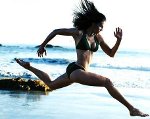 The majority of studies that have examined the effects of active recovery versus passive recovery on performance during long duration sprint exercise have shown similar results. McMurray (1969) reported no differences after different modes of passive recovery compared to active recovery in performance of a 200-yard swim. In four different conditions, following a standard load exercise, the swimmers rested passively in an upright position, in supine, stood still in the water, or swum slowly during recovery before a 200-yard test (McMurray 1969). Besides this early study, further studies reported beneficial performance outcome after active recovery in different protocols using cycling or swimming. Surprisingly, no running studies have tested the effect of active recovery between sprints of 40 to 120 s duration so far. During competitions, swimmers may be asked to participate in repeated races with an interval duration of 10 to 30 minutes. It is advised that during the interval period they should follow active recovery since experimental evidence suggests that this practiceis beneficial (Felix et al., 1997; Greenwood et al.,2008; Toubekis et al., 2008a). Repetitions of 100 m and 200 yard swimming may be performed faster when active recovery rather than passive recovery is applied during a 10 to 15 min interval (Felix et al., 1997; Greenwood et al., 2008; Toubekis et al., 2008a). The effective intensity of active recovery during the above studies was reported corresponding to 100 or 200-y best time (i.e 60% of the 100-m, 65% of the 200-yard; Toubekis et al., 2008a; Felix et al., 1997) or the lactate threshold (Greenwood et al., 2008).
The majority of studies that have examined the effects of active recovery versus passive recovery on performance during long duration sprint exercise have shown similar results. McMurray (1969) reported no differences after different modes of passive recovery compared to active recovery in performance of a 200-yard swim. In four different conditions, following a standard load exercise, the swimmers rested passively in an upright position, in supine, stood still in the water, or swum slowly during recovery before a 200-yard test (McMurray 1969). Besides this early study, further studies reported beneficial performance outcome after active recovery in different protocols using cycling or swimming. Surprisingly, no running studies have tested the effect of active recovery between sprints of 40 to 120 s duration so far. During competitions, swimmers may be asked to participate in repeated races with an interval duration of 10 to 30 minutes. It is advised that during the interval period they should follow active recovery since experimental evidence suggests that this practiceis beneficial (Felix et al., 1997; Greenwood et al.,2008; Toubekis et al., 2008a). Repetitions of 100 m and 200 yard swimming may be performed faster when active recovery rather than passive recovery is applied during a 10 to 15 min interval (Felix et al., 1997; Greenwood et al., 2008; Toubekis et al., 2008a). The effective intensity of active recovery during the above studies was reported corresponding to 100 or 200-y best time (i.e 60% of the 100-m, 65% of the 200-yard; Toubekis et al., 2008a; Felix et al., 1997) or the lactate threshold (Greenwood et al., 2008).
Performance in cyclingsprints
Exercise at intensity 120 to 130% of VO2max can be sustained for about 2 minutes before exhaustion. This intensity has been applied in the studies of Thiriet et al., (1993) and Dorado et al., (2004). Thiriet et al. (1993) reported improved performance when active recovery was used during the 20-min interval between 4x120 s bouts at an intensity 130% of the VO2max. The beneficial effects on performance were evident after either arms or legs cycling active recovery (Thiriet et al., 1993). When four repetitions at an intensity 120% of VO2max were performed until the participants were unable to maintain 70 rpm; active recovery applied during the 5 min interval improved performance by 3-4% compared to passive recovery (Dorado et al., 2004). Although the cycling bouts were performed up to exhaustion, the duration of each bout was not reported in the last study. Nonetheless, inspection of figure 3 of the paper reveals a time range from ~40 to ~120 s (Dorado et al., 2004). During sprints of this duration, aerobic contribution becomes more important with successive sprints (Bogdanis et al., 1996a). As the authors discussed an increased aerobic contribution and increased oxygen kinetics was the main reason for improved performance after active recovery compared to passive recovery (Dorado et al., 2004). The performance results reported in the above-mentioned studies are in agreement with previous findings of Weltman et al. (1977) who reported improved number of pedal revolutions despite no differences in mean power when active recovery was applied between two 60 s sprints after a 10 and 20 min interval. However, when a short recovery period (work to rest ratio 1:2.5) was used during repeated ice skating sprints, the distance covered during a series of 7x40 s repetitions was similar after active or passive recovery (Lau et al., 2001). The ice hockey players participated in the last study performed 7x40 s sprints with 90 s interval and repeated the same set of repetitions after a 15 min interval which included 12 minutes of self-selected cycling active recovery (Lau et al.,2001).
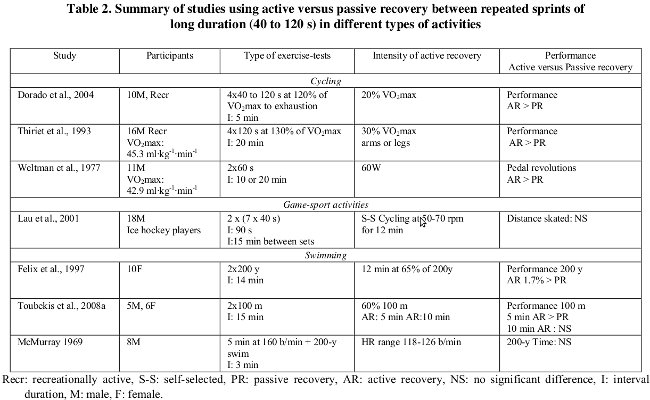
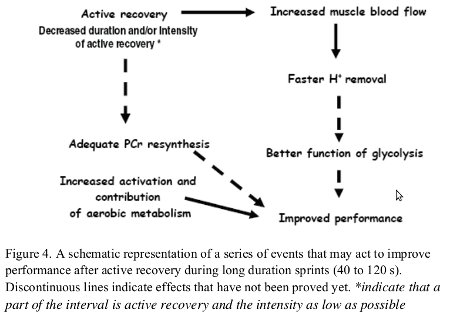
Figure 4. A schematic representation of a series of events that may act to improve performance after active recovery during long duration sprints (40 to 120 s).
Discontinuous lines indicate effects that have not been proved yet. *indicate that a part of the interval is active recovery and the intensity as low as possible
A summary of studies examined the effects of active versus passive recovery between 40 to 120 s sprints is shown in Table 2. It seems that active recovery is beneficial and maintains a better performance on subsequent bouts following sprints of long duration when a long interval is available (i.e. work to exercise ratio 1:10 to 1:15). However, important issues such as the intensity and duration of active recovery are still under research. The physiological factors that may contribute to increased performance after active recovery compared to passive recovery during long duration sprints are presented in Figure 4.
The effects of intensity of active recovery on sprint performance
The intensity of active recovery may be crucial for the performance outcome. Athletes should follow active recovery at a low energetic cost while at the same time muscle blood flow must be adequately increased. A low energetic cost may be necessary for a fast recovery of high energy phosphates while an adequate muscle blood flow is required for the removal of metabolic by-products. Recent studies examined the effects of different intensities of active recovery on performance. The intensity is expressed as a percentage of VO2maxduring cycling and team-game activities (Dupont et al., 2007; Spencer et al., 2008; Maxwell et al., 2008) as a percentage of the best time or as a percentage relative to the lactate threshold during swimming (Toubekis et al.,2006; Toubekis et al., 2010; Greenwood et al., 2008). During the 21 s interval between 6x4 s sprints, both active recovery intensities were applied at 20 or 35% of the VO2max and equally decreased peak power and total work compared to passive recovery in team-sport trained individuals (Spencer et al., 2008). Similarly, when active recovery intensities corresponding to 20 or 40% of the VO2maxwere compared to passive recovery, both decreased performance in a 30 s sprint performed shortly (15 s) after a 15 s sprint (Dupont et al., 2007). It is possible that the short interval duration or the small difference between intensities of active recovery applied in the studies of Spencer et al. (2008) and Dupont et al. (2007) have masked the effects of active recovery. This may have also occurred during repeated 25 m sprints with a 45 s interval when the active recovery intensity was 50 or 60% of the 100 m velocity (Toubekis et al., 2006). Using longer interval duration (120 s) and a greater difference between active recovery intensities on the same repeated swimming sprint protocol, the results were different from previous studies (Toubekis et al., 2010). In that study the low and high intensity active recovery were estimated to correspond to 36% and 59% of the VO2max (40% and 60% of the 100-m velocity). During passive recovery and active recovery at low intensity trials, performance was better compared to high intensity active recovery (Toubekis et al., 2010). However, in the repeated swimming sprint studies, performance of a subsequent 50 m sprint (duration ~30s) swum after six minutes, was unaffected by active recovery intensity (Toubekis et al., 2006; Toubekis et al., 2010). Therefore, it is likely that long interval duration (i.e. work to interval ratio 1:10 to 1:12) in combination with very low intensity of active recovery have a beneficial effect on performance compared to a high intensity active recovery.
A different approach to test the effects of swimming intensity during active recovery was applied by Greenwood et al., (2008). The authors calculated the velocity corresponding to the lactate threshold using a speed-lactate test and subsequently asked their swimmers to perform 2x200-yard sprints with a 10-min interval using passive recovery or active recovery. The active recovery intensities reported, were below, above or at the lactate threshold. It is interesting to note that performance during the second 200 yard sprint was improved not only compared to passive recovery but also compared to the first 200 yard sprint after active recovery at a velocity corresponding to the lactate threshold (Greenwood et al., 2008). It should be noted however, that the lactate threshold velocity can be calculated using different methods and readers should be aware that no single method can be used as a gold standard (Tokmakidis et al., 1998).
During game-sports activities, it has been shown that low intensity is beneficial compared to high intensity of active recovery (35 vs. 50% of VO2max) allowing a 3% better peak power during repeated 5 s cycling sprints (Maxwell et al., 2008). These 5 s sprints were performed within 20x2-min blocks. Within each 2 min block, a 10 s standing, 5 s sprint and 105 s of active recovery were performed (Maxwell et al., 2008). During a different protocol applied by Del Coso et al. (2010), the mean power output during a 4 s cycling sprint was not different after intermittent sets performed with different active recovery intensity and different interval duration but with equal energy expenditure. In summary, it seems that very low intensity combined with a long interval duration (exercise to interval ratio 1:10) may maintain performance similar to passive recovery during short duration sprints. In contrast, active recovery intensity at the lactate threshold velocity, which is still very low intensity, may be beneficial not only to maintain but in some cases may improve performance on a subsequent sprint of 60 to 120 s duration.
The effect of exercise mode during active recovery
Few studies applied a different mode of exercise during the sprint compared to that applied during active recovery. For example, Siebers and McMurray (1981) tested a 200 yard swim after a 15-min interval following a 2-min standard tethered swimming exercise at intensity 90% of VO2max. The study included two experimental conditions with active recovery walking or swimming. During the 15-min interval, swimmers either walked on the pool-deck (velocity 2.5 to 3 mph) or swum at self-selected intensity (moderate pace) for 10 minutes and then rested passively for the remaining 5 min. A limitation of this study was that the intensity of exercise was not specified. No difference was observed in the 200-yard swim although swimmers were 1% faster after swimming active recovery (Siebers and McMurray 1981).
Swimming or rowing active recovery was applied during the 14-min interval between two 200 yard sprints (Felix et al., 1997). The active recovery intensity corresponded to the 65% of the 200 yard velocity and to the 60% of the maximum heart rate for rowing and performed for 10 minutes within the 14-min interval period. Swimming times of the second 200 yard sprint were similar after swimming or rowing active recovery and both were faster compared to passive recovery condition (Felix et al., 1997). Active recovery at the same relative intensity with arms or legs (30% of the VO2max) was applied in the study of Thiriet et al., (1993). Both modes of active recovery improved performance compared to passive recovery (Thiriet et al., 1993).
It seems that the mode of active recovery is not critical for the performance outcome on a subsequent bout at least when a long interval is provided and the tested exercise bout is a long duration sprint (i.e. ~120 s). A summary of studies which examined the effects of the intensity of active recovery or different modes of active recovery on performance are shown onTable 3.
The effects of active recovery duration on performance
When several experimental protocols apply active recovery between repetitions, there is a need to stop the participant for blood sampling. Thus, part of the interval between sprints is passive recovery and the remaining is active. This means that although the recovery is characterized as active, in fact, it is partially active and partially passive. The extent of this passive rest period within an active interval may affect the recovery process. In the studies of Felix et al., (1993), Siebers and McMurray (1981), Toubekis et al. (2008), during active recovery conditions, almost 1/3 of the interval was passive recovery. Only one study has examined the effects of active recovery duration on performance. Toubekis et al. (2008a) found that when a 15-min interval is provided, a 5-min active recovery was appropriate to enhance performance compared to a 10-min active and 15-min passive recovery. In the study of Del Coso et al. (2010), the different duration of active recovery of 4.5, 6 or 9 min, was designed to demand the same energy expenditure applying intensities corresponding to 24, 18 or 12% of the respiratory compensation threshold.
Despite the differences in duration and intensity of active recovery, the performance on a subsequent 4 s sprint was not different between conditions. It is likely that a combination of active and passive recovery may be beneficial between long duration sprints, and the appropriate duration of active recovery which may also depend on the intensity and duration of the tested sprint remains to be examined.
Active recovery during various types of exercise
Despite performance time, mean power, peak power and total work measured in most of the studies, there are other specific sport abilities that should be examined after active recovery compared to passive recovery. The evaluation of isometric muscle force and muscle torque during isokinetic contractions are important parameters for specific sports performance. Several studies examined the force and isokinetic muscle function after active or passive recovery. Following a 60 s maximum exercise at 150% of VO max, active recovery (cycling at 30 % of VO2max) or passive recovery had no positive or negative effect onpeak torque and total work of the dominant quatriceps during 60 repetitions (~90 s) performed at an angular velocity 150o·s-1 (Bond et al., 1991). In contrast, the maximum torque measured at an angular velocity of 60o·s-1 was increased after 15 minutes of active recovery at 30% but not after active recovery at 60% of the VO2max(McEniery et al., 1997).
The maximum voluntary contraction (MVC:isometric force) was measured after low intensity (50% of MVC) isometric contraction to fatigue and improved after a 5-min active recovery cycling at 10W (60 rpm) compared to passive recovery (Mika et al., 2007). Furthermore, the isometric hand-grip force, which may be important for climbing, was reduced during the 30 minutes after a climbing trial (Watts et al., 2000). The reduction in isometric hand-grip force was significantly greater one minute after the trial when the climbers applied recumbent cycling at 25W as active recovery compared to passive recovery (Watts et al., 2000).
Partially active recovery (5 min active plus 5 min passive) was applied during the 10-min interval separating the six competitive men’s gymnastics events (floor, pommel, rings, vault, parallel bars, horizontal bar), and this practice helped the participants to achieve higher scores compared to passive recovery (Jemni et al., 2003). The different protocols applied and the limited number of studies where the isometric muscle force or muscle torque was examined do not allow us to reach a firm conclusion concerning the
effectiveness of active recovery on muscle function. Further research is needed to examine the efficacy of active recovery under specific sport conditions. A summary of the findings concerning muscle function and specific sport activities ispresented in Table 4.
Active Recovery Following a Game or Training Session and Performance
Performance in team sports
Athletes are advised to follow a cool-down practice after a high intensity training session or after competition. The main reason for this practice is to enhance the lactate removal and recovery of homeostasis. It is believed that this will facilitate the recovery of performance before the next session. However, active recovery following a training session may not offer any advantage for performance (Barnett, 2006).
Table 3. Effects of different intensities or different types of active recovery compared to passive recovery during repeated sprints in various types of exercise
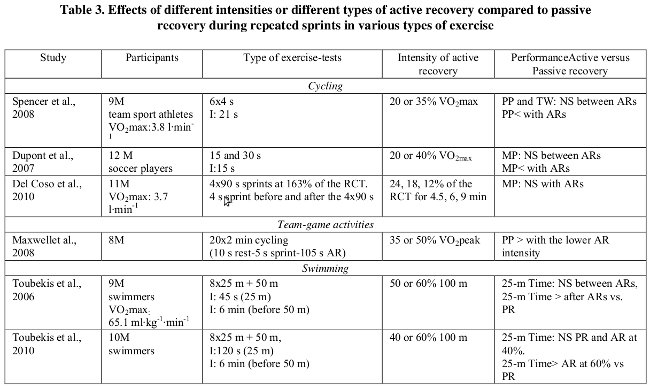
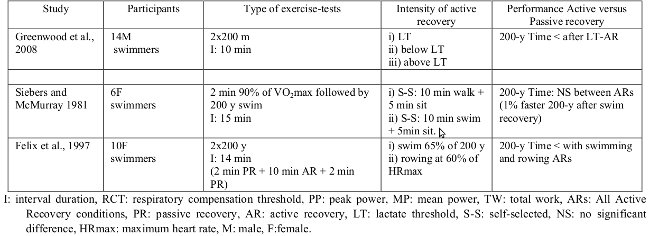
I: interval duration, RCT: respiratory compensation threshold, PP: peak power, MP: mean power, TW: total work, ARs: All Active Recovery conditions, PR: passive recovery, AR: active recovery, LT: lactate threshold, S-S: self-selected, NS: no significant difference, HRmax: maximum heart rate, M: male, F:female.
Table 4. Effects of active recovery following various types of athletic activities
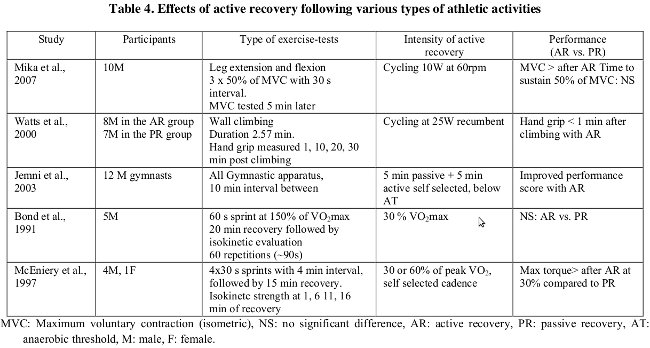
MVC: Maximum voluntary contraction (isometric), NS: no significant difference, AR: active recovery, PR: passive recovery, AT:
anaerobic threshold, M: male, F: female.
More recent studies have investigated the effectiveness of active recovery immediately after a training session on performance before the next session. Tessitore et al. (2007) and Tessitore et al. (2008) examined the effects of different modes of 20 min active and passive recovery following a soccer training session and following futsal soccer games on performance 5 hours later. It was found that performance on several anaerobic tests such as the squat-jump, the countermovement jump, bounce-jump and 10 m sprint time were not affected by the mode of recovery, which included dry-land or water-based active recovery, electrostimulation, or passive rest (Tessitore et al., 2007, 2008). It is likely that the training stimulus was moderate and the recovery process of these athletes following training or competition was well-designed (players followed proper hydration and nutrition) and these may have masked any effect of the recovery interventions.
A study applied with international level female soccer players extended the performance testing 69 hours following a friendly game between national teams (Andersson et al., 2008). Active recovery was applied 22 and 46 hours following the match and included 60 minutes of low intensity cycling and low intensity resistance training (60% of HRmax; <50%1RM). Performance during a 20-m sprint, countermovement jump and isokinetic strength were not different following either active or passive recovery (Andersson et al., 2008).
Similar results were obtained by King and Duffield (2009) in female netball players after a session including various sport specific activities. Fifteen minutes of active recovery at an intensity of 40% of the velocity at VO2max (vVO2max) or passive recovery showed similar effects on performance during five vertical jumps height and five 20-m sprints time both tested before a second session 24-hours later (King and Duffield 2009). The total stress imposed to the athletes during these non-controlled game-sport conditions is high enough to cause fatigue. Probably the active recovery applied after training session or a match is not appropriate to enhance performance recovery of selected tests in well-trained players. However, the effect of active recovery on the next training session on the overall game performance has not so far examined.
Performance in individual sports
During a laboratory setting, it is possible to control the load applied on the subjects. A controlled high intensity cycling protocol was applied by Lane and Wenger (2004) to examine the effects of several types of recovery on performance 24 hours later. Ten active males performed a series of 22 sprints ranging in duration from 5 to 15 s all applied with a work to rest interval 1:5.
Following this high intensity session, the participants followed a 15-min massage, cold water immersion, active recovery at an intensity of 30% of VO2max and passive recovery on four experimental conditions. Performance measured in the same 22 sprints 24 hours later was maintained in all recovery conditions (massage, cold water immersion, active recover) but was reduced after passive recovery (Lane and Wenger 2004).
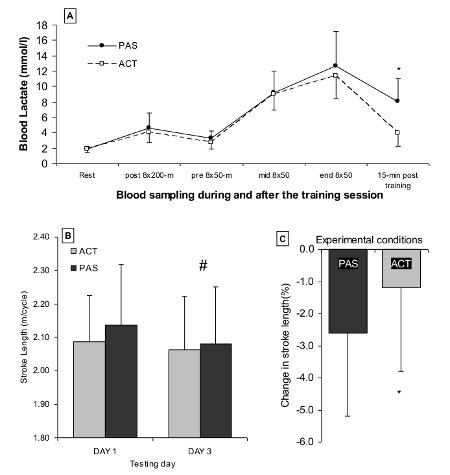
Figure 5. Blood lactate changes (panel A) during the training session followed either by passive or active recovery. Changes in stroke length (panel B) and percentage changes in stroke length (panel C) the days before (DAY 1) and the day after (DAY 3) the training session. * indicate p<0.05 between ACT and PAS conditions, # indicate differences between DAY 1 and DAY 3. (Data from Tsami et al., 2006; Reproduced with permission)
Table 5. The training content followed during the study of Tsami et al., (2006)
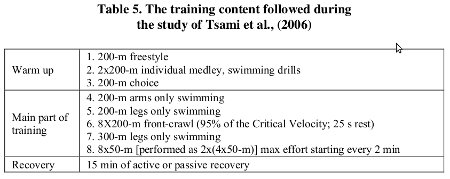
Table 6. The effects of active recovery applied after a training session or competition on performance during the following session or the following day


MP: mean power, CMJ: countermovement jump, VJ: vertical jump, SJ: squat jump, BJ: bounch jump, SL: stroke length, F: female, M: male, AR: active recovery, PR: passive recovery, NS: no significant difference after active or passive recvery.
In addition to cycling, swimming training intensity can be precisely controlled in the field (swimming pool). The effects of active or passive recovery were studied after a high intensity training session in young swimmers (Tsami et al., 2006). The swimmers completed a training session including high intensity aerobic and anaerobic contents (see Table 5). The day before training and the day after training, swimmers performed a 50-m maximal and a 400-m sumbaximal (85% of the best time) test for the evaluation of metabolic and temporal parameters (stroke rate and stroke length). Fifteen minutes of active recovery at a pace corresponding to 60% of the 100-m velocity were applied immediately after the training session and helped to maintain a higher stroke length compared to passive recovery on the 400-m sub-maximal test but had no effects on the maximum intensity 50-m sprint time the day after training (Figure 5; Tsami et al., 2006). The results from studies in individual sports are not conclusive but support the use of a 15-min low intensity active recovery following a training session. A summary of studies using active recovery after a training session or competition are shown in Table 6.
CONCLUSION
Active recovery compared to passive recovery is strongly associated with greater metabolic demands, and this has an impact on performance. Active recovery should be used by athletes between sprint repetitions with a duration-time-period of 40 to 120 s to enhance the lactate removal and possibly result in a faster restoration of muscle pH. The application of this practice at an intensity below or at the lactate threshold (i.e., exercise that will not add more lactate to the circulation) may maintain performance and in some cases, when only two sprint bouts are performed, it may help to enhance performance. When a long duration-interval-period is available between sprints (i.e., 15 to 20 min), the application of active recovery for the 1/3 of that period, while leaving some time for passive recovery, may be beneficial. Under these conditions, the faster pH restoration, increased activation and contribution of
aerobic metabolism and adequate PCr resynthesis may be beneficial to performance during training and competition.
Active recovery should not be used, when a short interval (i.e., 20 to 120 s) is provided, between sprints with a duration-time-period of 4 to 15 s. This practice will increase the energy cost because of the oxygen required for exercise, thus preventing the muscle re-oxygenation leading to inadequate PCr resynthesis and decreased performance. However, during team-sport games it is not practical to advise players to stand passively after a sprint. The game demands, in many cases, require slow intensity running between sprints. Thus, active recovery between sprints should become a routine training practice.
When a long duration-interval-period (i.e., more than 3 to 4 min) is available between sprints of 15 to 30 s, a very low intensity active recovery may maintain performance similar to that after passive recovery.
There is no adequate evidence to suggest that active recovery applied following a training session is beneficial in team sports. However, in individual sports and when high intensity training has been applied, it is likely that active recovery may benefit the performance outcome during the next training session. Clearly, this cannot be attributed to lactate or other currently known metabolic factors.
ACTIVE VERSUS PASSIVE RECOVERY BETWEEN LONG DURATION (40 TO 120 S) SPRINTS
ACTIVE RECOVERY VERSUS PASSIVE RECOVERY BETWEEN SHORT DURATION (4 TO 30 S) SPRINTS
REFERENCES
- Ahmaidi, S., Granier, P., Taoutaou, Z., Mercier, J., Dubouchaud, H.& Prefaut,C. (1996). Effects of active recovery on plasma lactate and anaerobicpower following repeated intensive exercise. Med Sci Sports Exerc.,28(4),450-456.
- Andersson, H., Raastad, T., Nilson, J., Paulsen, G., Garthe, I.& Kadi, F.(2008). Neuromascular fatigue and recovery in elite female soccer: Effectsof active recovery. Med Sci Sports Exerc.,40(2), 372-380.
- Baldari, C., Videira, M., Madeira, F., Sergio, J.& Guidetti, L. (2004). Lactateremoval during active recoveryEur J Appl Physiol., 93(1-2), 224-230.
- Baldari, C., Videira, M., Madeira, F., Sergio, J.& Guidetti, L. (2005). Bloodlactate removal during recovery. J Sports Med Phys Fitness, 45(4), 460-466.
- Bangsbo, J., Johansen, L., Graham, T.& Saltin, B. (1993). Lactate and H+effluxes from human skeletal muscle. J Physiol., 462, 115-33.
- Bangsbo, J., Graham, T., Johansen, L.& Saltin, B. (1994). Muscle lactatemetabolism in recovery from intense exhaustive exercise: impact of lightexercise. J Appl Physiol.,77(4),1890-1895.
- Beckett, K.& Steigbigel, B.A. (1993). Effects of warm down techniques on theremoval of lactate acid following maximal human performance. J.Swimming Research, 9, 32-35.
- Barnett, A. (2006). Using recovery modalities between training sessions inelite athletes, Does it help? Sports Med, 36, 781-796.
- Belcastro, A.& Bonen, A. (1975). Lactic acid removal rates during controlledand uncontrolled recovery exercise. J Appl Physiol., 39(6), 932-936.
- Bogdanis, G., Nevill, M., Boobis, L., Lakomy, H.& Nevill, A. (1995).Recovery of power output and muscle metabolites following 30 s of maximal sprint cycling in man. J Physiology., 482(2), 467-480.
- Bogdanis, G., Nevill, M., Lakomy, H., Graham, C.& Louis G. (1996). Effects of active recovery on power output during repeated maximal sprint cycling. Eur J Appl Physiol., 74,461-469.
- Bogdanis, G.C., Nevill, M.E., Boobis, L.H.& Lakomy, H.K. (1996a).Contribution of phosphocreatine. J Appl Physiol., 80(3),876-84.
- Bogdanis, G., Nevill, M., Lakomy, H.K.& Boobis, L.H. (1998). Power output and muscle metabolism during and following recovery from 10 and 20 s of maximal sprint exercise in humans. Acta Physiol Scand, 163, 261-272.
- Bonen, A. & Belcastro, A. (1976). Comparison of self-selected recovery methods on lactic acid removal. Med Sci Sports Exerc., 8(3), 176-178.
- Bonen, A., Campbell, C.J., Kirby, R.L.& Belcastro, A.N. (1978). Relationship between slow-twitch muscle fibres and lactic acid removal. Can J Appl Sports Sci., 3, 160-162.
- Bond, V., Adams, R., Tearney, R., Gresham, K.& Ruff, W. (1991). Effects of active and passive recovery on lactate removal and subsequent isokinetic muscle function. J Sports Med Phys Fitness, 31(3), 357-361.
- Brooks, G.& Gaesser, G. (1980). End points of lactate and glucose metabolism after exhaustive exercise. J Appl Physiol., 49(6), 1057-1069.
- Brooks, G. (1986). The lactate shuttle during exercise and recovery. Med Sci Sports Exerc., 18(3), 360-368.
- Buchheit, M.,Cormie, P.,Abbiss, C.R.,Ahmaidi, S.,Nosaka, K.K.&Laursen, P.B.(2009).Muscle deoxygenation during repeated sprint running: Effect of active vs. passive recovery., Int J Sports Med., 30(6), 418-425.
- Buchheit, M.,A. l., Haddad, H.,Chivot, A.,Leprêtre, P.M.,Ahmaidi, S.&Laursen, P.B. (2010).Effect of in versus out-of-water recovery on repeated swimming sprint performance. Eur J Appl Physiol., 108(2),321-327.
- Cazorla, G., Dufort, C.& Cervetti, J. (1983). The influence of active recovery on blood lactate dissapearance after supramaximal swimming. In International Series on Sport Sciences Vol 14, R. Nelson,& C.Morehouse, (series Ed), Biomechanics and Medicine in Swimming,P.Hollander, P. Huijing, G. de Groot (eds), Biomechanics and Medicine in Swimming, 244-250, Champain, Illinois, Human Kinetics Publishers, Inc.
- Casey, A.,Constantin-Teodosiu, D.,Howell, S.,Hultman, E.&Greenhaff, P.L.(1996). Metabolic response of type I and II muscle fibers during repeated bouts of maximal exercise in humans. Am J Physiol., 271,E38-43.
- Castagna, C., Abt, G., Manzi, V., Annino, G., Padua, E.& D'Ottavio, S. (2008). Effect of recoveryJ Strength Cond Res., 22(3), 923-929.
- Choi, D., Cole, K.J., Goodpaster, B.H., Fink, W.J.& Costill, D.L. (1994). Effect of passive. Med Sci Sports Exerc., 26(8),992-996.
- Connolly, D., Brennan, K.& Lauzon, C. (2003). Effects of active versus passive recovery on power output during repeated bouts of short term, high intensity exercise. Journal of Sports Science and Medicine, 2, 47-51.
- Del Coso, J., Hamouti, N., Aguardo-Jimenez, R.& Mora-Rodriguez, R. (2010). Restoration of blood pH between repeated bouts of high-intensity exercise: effects of various active-recovery protocols. Eur J Appl Physiol.,108,523-532.
- Delp, M.D.& Laughlin, M.H. (1998). Regulation of skeletal muscle. Acta Physiol Scand, 162(3),411-419.
- Denadai, B., Guglielmo, L.& Denadai, M. (2000). Effect of exercise mode on the blood lactate removal during recovery of high-intensity exercise.
- Biology of Sport, 17,37-45. Dorado, C., Sanchis-Moysi, J.& Galbet, J.A.L. (2004). Effects of recovery mode on performance, O2 uptake, and O2 deficit during high-intensity intermittent exercise. Can J App. Physiol, 29(3), 227-244.
- Dupont, G., Moalla, W., Matran, R. & Berthoin, S. (2007). Effect of short recovery intensities on the performance during two wingate tests. Med Sci Sports Exerc.,39,1170-1176.
- Essen, B., Pernow, B., Gollnick, P.& Saltin, B. (1975). Muscle glycogen content and lactate uptake in exercising muscles. In H. Howald,& J.R. Poortmans, (eds),Metabolic adaptations to prolonged physical exercise, 130-134, Basel, Karger.
- Ettema, G.&Lorås, H.W.(2009). Efficiency in cycling: a review. Eur J Appl Physiol, 106(1), 1-14.
- Fairchild, T., Armstrong, A., Rao, A., Liu, H., Lawrence, S.& Fournier, P. (2003). Glycogen synthesis in muscle fibers during active recovery from intense exercise. Med Sci Sports Exerc., 35(4), 595-602.
- Felix, S., Manos, T., Jarvis, A., Jensen, B.& Hardley, S. (1997). Swimming performance following different recovery protocols in female collegiate swimmers. J. Swimming Research, 12, 1-6.
- Fournier, P., Fairchild, T., Ferreira L.& Brau, L. (2004). Post-exercise muscle glycogen repletion in the extreme: effect of food absence and active recovery. Journal of Sports Science and Medicine, 3,139-146.
- Gaitanos, G., Williams, C., Boobis, L.& Brooks S. (1993). Human muscle metabolism during intermittent maximal exercise. J Appl Physiol., 75(2), 712-719.
- Gisolfi, C., Robinson, S.& Turrell, E. (1966). Effects of aerobic work performed during recovery from exhausting work. J Appl Physiol, 21(6), 1767-1772.
- Gladden, L.B. (2004). Lactate metabolism: a new paradigm for the third millenium. J Physiol, 558,1, 5-30.
- Gollnick, P., Warwick, B.& Hodgson, D. (1986). Exercise intensity, training, diet, lactate concentration in muscle and blood. Med Sci Sports Exercise,18(3), 334-340.
- Greenhaff, P., Nevill, M., Soderlund, K., Bodin, K., Boobis, L., Williams, C.& Hultman, E. (1994). The metabolic responses of human type I and II muscle fibres during maximal treadmill sprinting. J Physiol, 478,1, 149-155.
- Greenwood, J., Moses, E., Bernardino, M., Gaesser, G.& Weltman, A. (2008). Intensity of exercise recovery,blood lactate disappearance, and subsequent swimming performance.J Sports Sci., 26(1), 29-34.
- Hargreaves, M., McKenna. M., Jenkins, D., Warmington, S., Li, J.& Snow, R., et al. (1998). Muscle metabolites and performance during high-intensity, intermittent exercise. J Appl Physiol, 84(5), 1687-1691.
- Haseler, L.,Hogan, M. & Richardson R. (1999).Skeletal muscle phosphocreatine recovery in exercise-trained humans is dependent on O2 availability. J Appl Physiol, 86(6), 2013-2018.
- Hogan, M.C., Richardson, R.S.& Haseler, L.J. (1999). Human muscle performanceJ Appl Physiol, 86(4),1367-1373.
- Hermansen, L. & Stensvold, I. (1972). Production and removal of lactate during exercise in man. Acta Physiol Scand, 86, 191-201.
- Hermansen, L. & Vaage, O. (1977). Lactate disappearance and glycogen synthesis in human muscle after maximal exercise. Am J Physiol, 233, E422-E429.
- Hildebrandt, W., Schutze, H.& Stegemann, J. (1992). Cardiovascular limitations of active recovery from strenuous exercise. Eur J Appl Physiol, 64, 250-257.
- Active versus Passive Recovery: Metabolic Limitations and...Holmer, I., Stein, E., Saltin, B., Ekblom, B.& Astrand, P.O. (1974).
- Hemodynamic and respiratory responses compared in swimming and running. J Appl Physiol, 37(1), 49-54.
- Issekutz, B., Shaw, W.& Issekutz, A. (1976). Lactate metabolism in resting and exercising dogs. J Appl Physiol, 40(3), 312-319.
- Jemni, M., Sands, W., Friemel, F.& Delamarche, P. (2003). Effect of active and passive recovery on blood lactate and performance during simulated competition in high level gymnasts. Can J Appl Physiol, 28(2), 240-256.
- Johnson, E., Hudson, T.& Greene,E. (1990). Left ventricular hemodynamics during exercise recovery. J Appl Physiol, 69(1), 104-111.
- King, M.& Duffield, R. (2009). The effects of recoveryJ Strength Cond Res., 23(6),1795-1802.
- Krukau, M., Volker, K.& Liesen H. (1987). The influence of sport-specific and sport-unspecific recovery on lactate-behaviour after anaerobic swimming.Int J Sports Med, 8,142.
- Lane, K.N.& Wenger, H.A. (2004). Effect of selected recoveryJ Strength Cond Res., 18(4),855-860.
- Lau, S., Berg, K., Latin, R.W.& Noble, J. (2001). Comparison of active and passiveJ Strength Cond Res., 15(3),367-371.
- Laughlin, H.& Armstrong P. (1985). Muscle blood flow during locomotoryexercise. Ex Sports Sci Rev., 13, 95-136.
- Lindinger, M., Heigenhauser, G., McKelvie, R.& Jones, N. (1990). Role of nonworking muscle on blood metabolites and ions with intense intermittent exercise. Am J Physiol., 258(27), R1486-R1494.
- Matsushique, K., Schneck, H., Hoianaski, L.& Franchini, E. (2007). Performance in all-out intermittent short-duration exercise bouts: Active vs passive recovery. Rev. Bras. Cineantropom. Desempenho Hum, 9,37-43 (article in Spanish, English abstract)
- Maxwell, N.S., Castle, P. C. & Spencer, M. (2008). Effect of recoveryJ Sci Med Sport, 11(5),491-499.
- McAinch, A., Febbraio, M., Parkin, J., Zhao, Z., Tangalakis, K., Stojanovska, L.& Carey, M. (2004). Effects of active versus passive recovery on metabolism and performance during subsequent exercise. International Journal of Sports Nutrition and Exercise Metabolism, 14,185-196.
- McGrail, J., Bonen, A.& Belcastro, A. (1978). Dependence of lactate removal on muscle metabolism in man. Eur J Appl Physiol, 39, 89-97.
- McEniery, C.M., Jenkins, D.G.& Barnett, C. (1997). The relationship. Eur J Appl Physiol Occup Physiol, 75(5),462-426.
- McLoughlin, P., McCaffrey, N.& Moynihan, J.B. (1991). Gentle exercise. Eur J Appl Physiol Occup Physiol, 62(4),274-278.
- McLellan, T. & Skinner, J. (1982). Blood lactate removal during active recovery related to the aerobic threshold. Int J Sports Med, 3, 224-229.
- McMaster, W., Stoddard, T.& Duncan, W. (1989). Enhancement of lactate recovery by continuous sub-maximal swimming. J Swimming Research, 5(2), 19-21.
- McMahon, S. & Jenkins, D. (2002). Factors affecting the rate of phosphocreatine resynthesis following intense exercise. Sports Med, 32,761-784.
- McMurray, R. (1969). Effects of body position and immersion on recovery after swimming exercise. Research Quarterly, 40(4), 738-742.
- Mika, A.,Mika, P.,Fernhall, B.&Unnithan, V.B.(2007). Comparison of recovery strategies on muscle performance after fatiguing exercise. Am J Phys Med Rehabil, 86(6),474-481.
- Pascoe, D.D.& Gladden, L.B. (1996). Muscle glycogen. Sports Med, 21(2),98-118.
- Peters-Futre,E.M.,Noakes, T.D.,Raine, R.I.&Terblanche, S.E. (1987). Muscle glycogen repletion during active postexercise recovery. Am J Physiol, 253,E305-311.
- Reaburn, P.R.& Mackinnon L.T. (1990). Blood lactate responses in older swimmers during active and passive recovery following maximal sprint swimming. Eur J Appl Physiol, 61, 246-250.
- Rowel, L. (1993). Human Cardiovascular Control. OxfordUniversity Press.
- Sahlin, K., Harris, R.& Hultman, E. (1979). Resynthesis of creatine phosphate in human muscle after exercise in relation to intramuscular pH and availability of oxygen. Scand. J Clin Lab Invest, 39, 551-558.
- Sairyo, K., Iwanaga, K., Yoshida, N., Mishiro, T., Terai, T.& Sasa, T., et al. (2003). Effects of active recovery under a decreasing work load following intense muscular exercise on intramuscular energy metabolism. Int J Sports Med, 24, 179-182.
- Siebers, L.& McMurray, R. (1981). Effects of swimming and walking on exercise recovery and subsequent swim performance. Research Quarterly, 52(1),68-75.
- Signorile, J.F., Ingalls, C.& Tremblay, L. (1993). The effects of active and passive recovery on short-term high intensity power output. Can J Appl Phys., 18(1), 31-42.
- Sjogaard, G. (1987). Muscle fatigue. In P. Marconnet, & P. Komi, (Eds) Medicine Sport Sci, Vol. 26, Muscular Function in Exercise and Traiming, 98-109, Basel: Karger.
- Smith, P.M., Doherty, M.& Price, M.J. (2006). The effect of crank rate on physiological responses and exerciseInt J Sports Med, 27(3),199-204.
- Spencer, M., Bishop, D., Dawson, B., Goodman, C.& Duffield, R. (2006). Metabolism and performance in repeated cycle sprints: Active versus Passive recovery, Med Sci Sports Exerc.,38(8), 1492-1499.
- Spencer, M., Dawson, B., Goodman, C., Dascombe, B.& Bishop, D. (2008). Performance and metabolism in repeated sprint exercise: effect of recovery intensity. Eur J Appl Physiol,103,545-552.
- Spierer, D.K., Goldsmith, R., Baran, D., Hryniewicz, K.& Katz, S. (2004). Effects of active vs. passive recovery on work performed during serial supramaximal exercise tests. Int J Sports Med, 25,109-114.
- Stamford, B.A., Weltman, A., Moffatt, R.& Sady, S. (1981). Exercise recovery above and below anaerobic threshold following maximal work. J Appl Physiol, 51(4), 840-844.
- Stanley, W.C.,Gertz, E.W.,Wisneski, J.A.,Morris, D.L.,Neese, R.A.&Brooks, G.A. (1985). Systemic lactate kinetics during graded exercise in man. Am J Physiol, 249, E595-602.
- Suzuki, M.& Bonde-Peterson, F. (1983). Heart Rate and muscle hyperaemia in leg muscles after sprint running. Eur J Appl Physiol, 51, 183-194.
- Taoutaou, Z., Granier, P., Mercier, B., Mercier, J., Ahmaidi, S.& Prefaut C. (1996). Lactate kinetics during passive and partially active recovery in endurance and sprint athletes. Eur J Appl Physiol, 73, 465-470.
- Tessitore, A., Meeusen, R., Cortis, C.& Capranica, L. (2007). Effects of different recoveryJ Strength Cond Res., 21(3),745-50.
- Tessitore, A., Meeusen, R., Pagano, R., Benvenuti, C., Tiberi, M.& Capranica, L. (2008). Effectiveness of active versus passiveJ Strength Cond Res., 22(5),1402-12.
- Thiriet, P., Gozal, D., Wouassi, D., Oumarou, T., Gelas, H.& Lacour, J. (1993). The effect of various recovery modalities on subsequent performance, in consecutive supramaximal exercise. J Sports Med Phys Fitn, 33(2), 118-129.
- Tokmakidis, S.P., Léger, L.& Pilianidis, T. (1998). Failure to obtain a unique threshold on the blood lactate concentration curve during exercise. Eur J Appl Physiol,77,333-342.
- Trump, M., Heigenhauser, G., Putman, C.& Spriet, L. (1996). Importance of phosphocreatine during intermittent maximal cycling. J Appl Physiol, 80(5), 1574-1580.
- Toubekis, A., Douda, H.& Tokmakidis, S.P. (2005). Influence of different rest intervals during active or passive recovery on repeated sprint swimming performance. Eur J Appl Physiol,93(5-6), 694-700.
- Toubekis, A., Smilios, I., Bogdanis, G., Mavridis, G.& Tokmakidis, S.P. (2006). Effect of different intensities of active recovery on sprint swimming performance. Appl Physiol Nutr Metab, 31,709-716.
- Toubekis, A., Peyrebrune, M., Nevill, M.E.& Lakomy, H.K. (2008). Effects of active and passive recovery on performance during repeated sprint swimming. J Sports Sci.,26,1497-1505.
- Toubekis, A., Tsolaki, A., Smilios, I., Douda, H., Kourtesis, T.& Tokmakidis, S.P. (2008a). Swimming performance after passive and active recovery of various durations. Int J Sports Phys Perf., 3,375-386.
- Toubekis, A., Adam, G., Douda, H., Antoniou, P., DouroundosI.& Tokmakidis S.P. (2010). Repeated sprint swimming performance after low or high intensity active and passive recoveries. J Strength Cond Res,(in press). Jan 21. [Epub ahead of print].
- Tsami, A., Toubekis, A., Douda, H., Gourgoulis, V.& Tokmakidis S.P. (2006). Effects of active recovery on swimming performance observed 24 hoursafter a high intensity training session. Exercise and Society: Journal of Sport Science, 42, 27-34 (in Greek, English abstract available).
- Watts, P.B., Daggett, M., Gallagher, P.& Wilkins, B. (2000). Metabolic response during sport rock climbing and the effects of active versus passiveInt J Sports Med, 21(3),185-190.
- Weltman, A., Stamford, B.A., Moffatt, R.J.& Katch, L.V. (1977). Exercise recovery, Lactate removal, and Subsequent high intensity exercise performance. Research Quarterly, 48(4),787-796.
- Westerblad, H. & Allen, D. (2003).Cellular mechanisms of skeletal muscle fatigue. Adv Exp Med Biol., 538, 563-570.
- Wilcock, I.M.,Cronin, J.B.&Hing, W.A. (2006). Physiological response to water immersion: a method for sport recovery?Sports Med, 36(9),747-65.
- Tsami, A., Toubekis, A., Douda, H., Gourgoulis, V. & Tokmakidis S. P. (2006). Effects of active recovery on swimming performance observed 24 hours after a high intensity training session. Exercise and Society: Journal of Sport Science, 42, 27-34 (in Greek, English abstract available).
- Watts, P. B., Daggett, M., Gallagher, P. & Wilkins, B. (2000). Metabolic response during sport rock climbing and the effects of active versus passive recovery. Int J Sports Med, 21(3), 185-190.
- Weltman, A., Stamford, B. A., Moffatt, R. J. & Katch, L. V. (1977). Exercise recovery, Lactate removal, and Subsequent high intensity exercise performance. Research Quarterly, 48(4), 787-796.
- Westerblad, H. & Allen, D. (2003). Cellular mechanisms of skeletal muscle fatigue. Adv Exp Med Biol., 538, 563-570.
- Wilcock, I. M., Cronin, J. B. & Hing, W. A. (2006). Physiological response to water immersion: a method for sport recovery? Sports Med, 36(9), 747-65.
